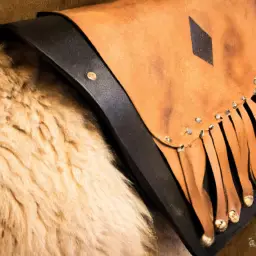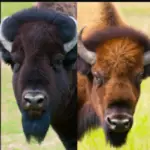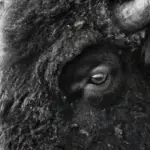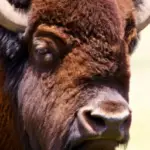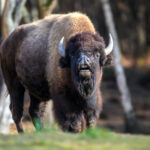Imagine a time when the vast prairies of North America were home to millions of bison, roaming freely across the plains. Now picture the arrival of white settlers, seeking to make their fortune in this new land. Curious about their perspective, the question arises: what part of the bison did these settlers consider valuable? In this article, we will explore the fascinating history behind the importance placed on certain parts of the bison by white settlers and the impact it had on both their lives and the ecosystem as a whole.
Historical Context of Bison Hunting
European settlers’ impact on bison population
During the 19th century, European settlers had a profound impact on the bison population in North America. As they moved westward, settlers began hunting bison on a massive scale for various reasons. The vast herds of bison provided an abundant source of meat, hides, bones, horns, hooves, fat, organs, and tallow. Unfortunately, this relentless hunting resulted in a rapid decline of the bison population, pushing the species to the verge of extinction.
Cultural and economic importance of bison for Native Americans
For Native Americans, the bison held immense cultural and economic significance. The bison was considered a sacred animal, representing strength, resilience, and sustenance. Native American tribes relied heavily on bison for food, clothing, tools, and shelter. They had an intimate understanding of the bison and deeply respected their natural environment. The decimation of the bison population by European settlers not only threatened their way of life but also caused immense cultural and economic devastation.
Policy involvements in bison hunting
The United States government played a significant role in bison hunting through various policies and actions. In the 19th century, as part of the colonization and westward expansion, the government aimed to drive Indigenous people off their lands and eliminate the bison, a critical resource for their survival. The implementation of policies such as the ‘Open Range Act’ and bounties on bison facilitated the mass slaughter of these magnificent animals. The government’s involvement in bison hunting had far-reaching consequences for both Native Americans and the bison themselves.
The Bison Hide
Use of bison hides in manufacturing
Bison hides were incredibly versatile and were used extensively in manufacturing during the settlement era. The durable and thick nature of the hides made them ideal for producing a wide range of products. Settlers utilized bison hides to make clothing, footwear, saddlebags, tents, blankets, and even covers for wagons. The strength and resilience of bison hides made them well-suited for enduring the harsh conditions of the frontier.
Trade value of bison hides
The trade value of bison hides skyrocketed during the settlement period. Traders and trappers recognized the profitability of the hide industry and established trading posts across the West. Bison hides were in high demand, both locally and internationally. The hides were traded for goods and supplies needed by the settlers and were exported to eastern markets and even Europe.
Effects of the hide industry on bison populations
The exponential increase in the demand for bison hides had devastating consequences for the bison population. Settlers, driven by profit and motivated by the desire to eliminate Native Americans’ main resource, embarked on a relentless campaign of mass hunting. This uncontrolled slaughter led to the decimation of the bison herds, rapidly depleting their numbers. The impact of the hide industry on bison populations was catastrophic, pushing the species to the brink of extinction.
Bison Meat
Nutritional value of bison meat
Bison meat is not only flavorful but also highly nutritious. It is leaner than beef and lower in fat and cholesterol, making it a healthier alternative for those seeking a well-balanced diet. Bison meat is an excellent source of protein, vitamins, and minerals while being lower in calories. Its exceptional nutritional value made it a valuable food source for settlers who relied on bison as a staple in their diet.
Preservation and preparation of bison meat by settlers
To preserve bison meat, settlers utilized various techniques, such as smoking, drying, and salting. These methods allowed them to extend the shelf life of the meat, enabling them to store and consume it for extended periods. Bison meat was commonly used in stews, jerky, sausages, and ground meat for burgers. The settlers’ knowledge of food preservation and preparation techniques played a crucial role in ensuring the availability of bison meat throughout the year.
Trade and commercialization of bison meat
The trade and commercialization of bison meat flourished during the settlement era. As the demand for bison meat grew, entrepreneurs recognized the opportunity for profit. Commercial hunting outfits were established to supply the increasing demand for bison meat both locally and in eastern markets. The trade of bison meat not only provided economic opportunities for settlers but also contributed to the further decline of the bison population.
Bison Bones
Industrial uses of bison bones
Bison bones found a wide range of industrial uses during the settlement period. Settlers utilized bison bones for the production of tools, buttons, and utensils. The marrow found within the bones was used for food, lubricants, and medicines. Additionally, bison bones were essential in the development of fertilizer, as they were ground into powder and spread onto fields to enhance soil fertility.
The bison bone trade
The trade of bison bones played a significant role in the settlement era. Carcasses left behind after hunting were often stripped of their bones. These bones were collected and transported to bone factories, where they were processed for various purposes. The bison bone trade was profitable and attracted scavengers who would scour the prairies for the remnants of the immense herds that once roamed the land.
Symbolic and cultural significance of bison bones
Bison bones held symbolic and cultural significance for Native American tribes. They were often used in rituals, ceremonies, and as sacred offerings. Bison skulls, decorated with intricate designs and ornaments, were displayed as symbols of strength and spirituality. The cultural significance of bison bones extended beyond Native American communities and became a poignant reminder of the loss and devastation caused by European settlement.
Bison Horns and Hooves
Use of bison horns in manufacturing
Bison horns were highly valued by settlers for their durability and versatile nature. They were used in the production of items such as buttons, combs, drinking vessels, and decorative pieces. Bison horns were also utilized in the manufacture of musical instruments, including horns and flutes. Their unique properties made them a sought-after resource in the frontier manufacturing industry.
Cultural significance of bison horns and hooves
Bison horns and hooves held great cultural significance for Native American tribes. They were used in ceremonies, rituals, and as decorative elements in traditional attire. Bison horns and hooves were believed to possess spiritual powers and were incorporated into various cultural practices. The symbolic significance of these body parts was deeply intertwined with Native American spirituality and cultural identity.
Trade value of bison horns and hooves
The trade value of bison horns and hooves was significant during the settlement period. They were sought after for their potential use in manufacturing and as curiosities or souvenirs. Entrepreneurs recognized the market demand for bison horns and hooves and established businesses to supply these items to both settlers and tourists. The trade of these body parts further contributed to the exploitation and decline of the bison population.
Bison Fat
Uses of bison fat
Bison fat had various practical uses during the settlement era. It was rendered to produce tallow, which was used in the production of candles, soap, and lubricants. Bison fat was also used for cooking and as a source of heat and light. The settlers found numerous applications for bison fat, harnessing its valuable properties for their daily needs.
Nutritional properties of bison fat
Bison fat provided a source of essential nutrients for settlers. It contained high levels of protein and calories, making it a valuable energy source. The nutritional properties of bison fat made it a highly desirable ingredient in their diet.
Trade and commercialization of bison fat
The trade and commercialization of bison fat were significant during the settlement period. Rendering plants were established to process the fat into tallow, which was then traded locally and internationally. The demand for bison fat and tallow for candle and soap production contributed to the economic exploitation of the bison population.
Bison Organs
Purposes of bison organs for settlers
Bison organs served various purposes for settlers during the settlement era. The organs were utilized for food, as settlers would consume the heart, liver, and kidneys. Additionally, certain organs were used for medicinal purposes or as ingredients in traditional remedies. Settlers found value in the organs for their nutritional and medicinal properties.
Medicinal uses of bison organs
Native American tribes and settlers alike recognized the medicinal properties of bison organs. The organs were used to treat various ailments and were believed to possess healing powers. For example, bison liver was used as a remedy for jaundice, while the bladder was utilized to treat urinary conditions. The medicinal uses of bison organs highlight the settlers’ reliance on the natural resources of the land.
Cultural significance of bison organs
Bison organs held cultural significance for Native American tribes. They were often used in ceremonies and rituals as offerings to the spirits or as symbols of fertility and strength. The cultural significance of bison organs reflected the deep connection between Native American communities and the bison.
Bison Tallow
Utilization of bison tallow in candle and soap making
Bison tallow played a crucial role in the production of candles and soap during the settlement era. Tallow, rendered from bison fat, was an essential ingredient in candle making. It provided a reliable source of light and heat, particularly in the absence of electricity. Bison tallow was also utilized in soap production, as it contributed to the lathering and cleansing properties of the soap.
Nutritional value and food preparation with bison tallow
Beyond its use in candle and soap making, bison tallow had nutritional value and was used in food preparation during the settlement era. It served as a cooking fat and added flavor and richness to various dishes. Bison tallow was commonly used for frying, baking, and roasting, providing both sustenance and culinary enjoyment for settlers.
Trade and market value of bison tallow
The trade and market value of bison tallow were significant during the settlement period. Tallow was in high demand for candle and soap production, both locally and internationally. Entrepreneurs established rendering plants and trading networks to meet the growing market demand. The commercialization of bison tallow further contributed to the exploitation and decline of the bison population.
Environmental and Ecological Impacts
Effects of bison hunting on ecosystems
The mass hunting of bison had severe ecological impacts on the prairie ecosystems. Bison played a vital role in maintaining the grasslands’ health and diversity through their grazing and trampling behaviors. With the drastic reduction in bison numbers, the grasslands underwent significant changes, affecting plant and animal species that depended on the bison for their survival. The loss of the bison’s ecological influence disrupted the delicate balance of the prairie ecosystem.
Biological implications of bison exploitation
The exploitation of bison had significant biological implications. The relentless hunting of bison for their various parts disrupted their natural reproductive cycle and social structures. As the bison population declined, their genetic diversity decreased, making them more susceptible to diseases and reducing their ability to adapt to changing environments. The biological implications of bison exploitation highlight the long-lasting effects of human interference on wildlife populations.
Conservation efforts for bison
In recent years, there have been concerted efforts to conserve and restore the bison population. Numerous organizations and government agencies have worked together to protect and preserve bison herds across North America. Reintroduction programs, protected habitats, and responsible management practices have contributed to the recovery of the bison population. These conservation efforts aim to ensure that future generations can appreciate the ecological and cultural significance of the bison.
Did the Depletion of the American Bison’s Population Impact the Valuable Parts Identified by White Settlers?
The american bison decline factors had a significant impact on the valuable parts identified by white settlers. As the bison population decreased, settlers relied less on the animal for food, clothing, and materials, leading to a shift in the economic and cultural significance of the bison in American history.
Modern Perspectives on Bison Value
Role of bison in contemporary sustainable agriculture
Bison are now recognized for their potential role in sustainable agriculture practices. They are well-suited to graze on native grasses, helping to restore and maintain prairie ecosystems. Bison also require less intervention and fewer resources compared to traditional livestock, making them an environmentally friendly choice for meat production. Their ability to thrive in harsh conditions and their low-impact grazing behavior position them as key players in sustainable agriculture.
Cultural revitalization and bison
The resurgence of interest in bison has sparked a cultural revitalization among Native American tribes and other communities. The bison’s significance in spirituality, art, and traditional practices has been rediscovered and honored. Bison ranching has become a way for tribes to reconnect with their heritage and regain control over their traditional territories. The cultural revitalization of the bison provides an opportunity for healing and the preservation of Indigenous cultures.
Changes in perceived value of bison parts
In contrast to the colonial-era perspective on bison parts, there has been a shift in the perceived value of these resources. Today, there is a growing appreciation for the intrinsic worth of the bison and respect for its role in the ecosystem. The focus is no longer solely on the economic value of individual bison parts but rather on the holistic value of the bison as a species and its contributions to biodiversity, cultural heritage, and sustainable living.
In conclusion, the historical context of bison hunting reveals the complex interplay between European settlers, Native Americans, and government policies. The exploitation of bison hides, meat, bones, horns, hooves, fat, organs, and tallow had tremendous cultural, economic, and ecological implications. However, the modern perspective on bison value highlights the importance of conservation, sustainable agriculture, and cultural revitalization. The bison’s journey from near extinction to a symbol of hope and resilience serves as a reminder of our responsibility to protect and cherish our natural heritage.

